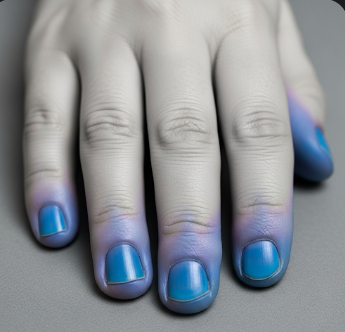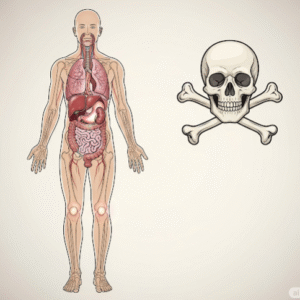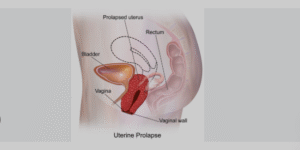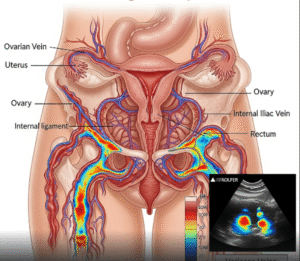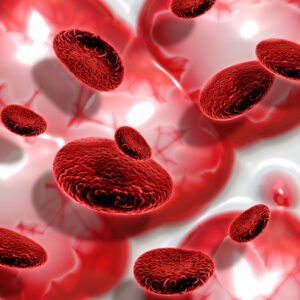Overview
Cyanosis is a medical condition characterized by a bluish or purplish discoloration of the skin, lips, or nail beds, indicating insufficient oxygen in the blood or poor circulation. It is often a sign of an underlying medical condition, ranging from mild respiratory issues to life-threatening cardiovascular or pulmonary disorders.
In South Korea, hospitals and specialized clinics provide advanced evaluation and treatment for cyanosis, using state-of-the-art diagnostic imaging, oxygen therapy, and multidisciplinary care to identify and manage the root cause effectively.
Key Facts
Highlights:
➡️ Cyanosis is visible as a bluish or purplish hue on the skin, lips, or nail beds.
➡️ It occurs due to low oxygen saturation in arterial blood or poor peripheral circulation.
➡️ Causes include heart disease, lung disorders, blood disorders, or congenital defects.
➡️ Cyanosis can be central (affecting lips and tongue) or peripheral (hands, feet, extremities).
➡️ Immediate medical assessment is crucial in South Korea, where modern diagnostic tools and emergency interventions are available.
What is Cyanosis?
Cyanosis is the clinical manifestation of reduced oxygenation in the blood, producing a distinct bluish or purplish skin coloration.
Key characteristics:
- Central Cyanosis: Bluish lips, tongue, and face due to systemic oxygen deficiency
- Peripheral Cyanosis: Bluish extremities (hands, feet) due to localized poor blood circulation
- Onset: Can be acute (sudden) or chronic (gradual) depending on underlying causes
- Severity: Indicates the extent of hypoxemia or circulatory compromise
Cyanosis itself is a sign, not a disease, and signals the need for urgent evaluation of respiratory or cardiovascular function.
What Symptoms are Related to Cyanosis?
Symptoms accompanying cyanosis vary with the underlying condition and may include:
- Shortness of breath or rapid breathing
- Fatigue or weakness
- Chest pain or palpitations
- Confusion or dizziness in severe oxygen deprivation
- Cold extremities or numbness in peripheral cyanosis
- Clubbing of fingers in chronic hypoxia
Highlights:
➡️ Cyanosis indicates reduced oxygen delivery to tissues, which can be life-threatening.
➡️ Central cyanosis often correlates with cardiac or pulmonary disease, while peripheral cyanosis usually indicates circulatory issues.
➡️ Early recognition allows timely intervention and prevents complications such as organ damage.
What Causes / Possible Causes of Cyanosis?
Highlights:
➡️ Respiratory Disorders: Chronic obstructive pulmonary disease (COPD), pneumonia, severe asthma, or pulmonary embolism.
➡️ Cardiac Conditions: Congenital heart defects, heart failure, or myocardial infarction reducing oxygenation.
➡️ Blood Disorders: Methemoglobinemia, polycythemia, or anemia affecting oxygen carrying capacity.
➡️ Peripheral Circulatory Issues: Raynaud’s phenomenon, shock, or arterial blockage leading to localized cyanosis.
➡️ Environmental Factors: Exposure to cold or high altitudes may trigger temporary cyanosis.
➡️ Mechanism: Cyanosis results from increased deoxygenated hemoglobin in capillaries or reduced arterial oxygen saturation, leading to visible blue or purple discoloration.
When Should I See My Doctor?
Highlights:
➡️ Immediate medical attention is required if cyanosis is sudden, severe, or accompanied by shortness of breath or chest pain.
➡️ If central cyanosis appears on the lips, tongue, or face, it may indicate serious cardiac or respiratory problems.
➡️ Peripheral cyanosis with cold or numb extremities should also be assessed urgently to rule out circulatory compromise.
➡️ Chronic or recurrent cyanosis warrants evaluation for underlying conditions such as congenital heart disease or chronic lung disease.
➡️ Early consultation ensures accurate diagnosis, rapid treatment, and prevention of organ damage or life-threatening complications.
Care and Treatment
Treatment focuses on improving oxygenation, addressing underlying causes, and supporting circulation:
Highlights:
➡️ Oxygen Therapy: Supplemental oxygen to increase blood oxygen saturation.
➡️ Medications:
- Bronchodilators for respiratory conditions
- Diuretics or heart medications for heart failure
- Blood disorder treatments, such as methylene blue for methemoglobinemia
➡️ Procedures and Interventions:
- Surgery for congenital heart defects or vascular blockages
- Mechanical ventilation in severe respiratory failure
- Blood transfusions or phlebotomy for hematologic conditions
➡️ Lifestyle and Supportive Measures:
- Avoid exposure to extreme cold
- Smoking cessation to improve lung function
- Pulmonary rehabilitation or cardiovascular exercise programs
➡️ Monitoring: Continuous assessment of oxygen saturation, vital signs, and cardiac and pulmonary function.
Treatment Options in Korea
South Korea provides advanced care for cyanosis, including:
Highlights:
➡️ Specialized Hospitals: Cardiology, pulmonology, and hematology departments equipped with state-of-the-art imaging and diagnostic tools.
➡️ Emergency Care: Rapid assessment and interventions for acute cyanosis in emergency and ICU settings.
➡️ Surgical and Minimally Invasive Procedures: Cardiac surgery, vascular interventions, and pulmonary procedures.
➡️ Multidisciplinary Approach: Collaboration among cardiologists, pulmonologists, hematologists, and critical care specialists for complex cases.
➡️ Medical Tourism Support: Multilingual consultations, advanced diagnostics, and personalized treatment plans for international patients.
➡️ Preventive Guidance: Lifestyle modifications, pulmonary rehabilitation, and chronic disease management to reduce recurrence and maintain optimal oxygenation.

